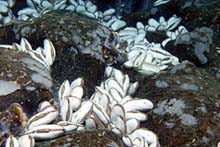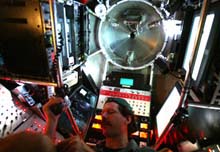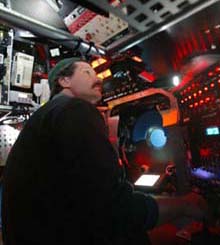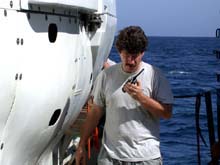
Numerous large clams and a small clump of mussels (bottom left) line the cracks between the pillow lavas at the new hydrothermal vent site discovered today. Click image for larger view.
Life Cycles of Vent Communities - So Much to Learn
May 31, 2002
The ship is now west of our former position, looking for more vent activity. After steaming through the night, we put the CTD over the side to survey for temperature anomalies. Seeing none, we continued west to another location that looked conspicuous on a reconnaissance chart. Our multibeam system showed a bottom area with some vent activity, the axial ridge bisected an extinct volcano. The Alvin dove this position, and with an exciting conclusion to the day, found vent mussel shells, but no living members of a vent community. The area was now dead. It is difficult to tell how long these communities can prosper, and how long it takes them to die. We are learning that the life on the axial ridge is quite dynamic on the geological time scale, and even on our time scale. A thriving, abundant vent community found just decades ago is gone, and a small new one is found. As we explore, we learn more of what and where our volcanic ocean has to offer, what secrets it keeps, and what amazing new life forms await our discovery and understanding.

On the way down to the Rosebud site, Chief Pilot BLee Williams looks to the communications astern in the sphere. Visible above him is the hatch of the sub. When this picture was taken, the sub was about one mile deep. Click image for larger view.
Essay/Interview with BLee Williams
Chief Pilot, Alvin
I am very proud and extremely lucky to be among the people who are exploring the Earth's oceans. Our team aboard Atlantis is, I think, the class of the world. From the mess attendant to the captain, from the chief engineer to the science tech, my shipmates do whatever it takes to get the ship to the dive site and the scientists to the bottom of the ocean, and back again. The Alvin Group maintains and operates the sub, but we couldn't do it without everyone's support.
Pride can be a weakness, but it is hard not to feel proud every time the sub returns from the bottom with a load of animals, rocks and data that can make a scientist's career. The Alvin group works long and hard, and our real pay is the beaming looks on the faces of the scientists as they swarm over the Alvin's basket, seeing what treasure we brought up from the bottom. It's very difficult for an oceanographer, especially an oceanographer with a deep benthic focus, to get samples and data. So difficult that there is no question that the scientists we see are driven by a curiosity and passion for the oceans that is more like a sickness than a gift.

On the bottom, BLee Williams pilots the Alvin through the newly discovered vent area called Rosebud. The responsibility and pride of the entire Alvin group is evident in all phases of the operation. Click image for larger view.
If they wanted to study animals, there are fields and woods aplenty. If they were geologists, rocks and dirt are right outside their doors. But our scientists are explorers of the first rate. They wait years in some cases for a single dive during which they can check their hypothesis and answer their questions. So our job here aboard Atlantis is to make sure, no matter what circumstances arise, that each dive is as long, as productive and as exciting as possible. A big part, and the best part, of my job is to see that that happens.
So far my luck has been fantastic, but not where the performance of my job or the safety of the sub is concerned. Where Alvin is concerned, luck ain't in it. It takes hard work, attention to detail and waking up thinking about how can we fix this or that problem. The luck I refer to is my luck at landing here aboard Atlantis. I grew up in eastern North Carolina and attended Wake Forest University, where I was a theater major. I didn't know what I wanted to do with my life, and ended up dropping out to consider the matter. I went into the navy wanting to be a cook. I had an idea about owning a restaurant someday. The navy quickly decided that what I wanted to be was a submariner working in nuclear power.
After a few weeks, they were able to convince me too. I ended up sailing aboard USS Memphis (SSN691) for six years as an electrician operating the nuclear power plant. I spent the last two years of my navy career as a mechanical engineer aboard the USS LY Spear repairing power plant equipment.
At the end of my 10 years in the navy, I had completed the requirements for a degree in sociology, and had a fantastic engineering education that stretched all the way from classroom-taught physics through how to run a engineering project as complicated as slurrying filter resin from a submarine's nuclear power plant in a floating dry dock in the middle of winter. The next logical step was refueling nuclear reactors.

Pilots do not dive every day, but while the ship is at sea and the Alvin is diving, every day is a work day for the entire Alvin group. Here, BLee is supervising the launch of Alvin while another pilot takes his turn diving for what amounts to a long day submerged, and a long evening maintaining the sub. All pilots contribute to the sub's maintenance and repair. These folks love their work. Click image for larger view.
I was part of the team that refueled USS Enterprise ![]() , the world's only eight reactor ship. Done properly (and we did it just so), refueling is very boring. So after three years I was thinking about moving on. During lunch one day I overheard some friends talking about Woods Hole and Alvin. They had seen a notice in the paper that Alvin needed an electrician with a background in submarines. Sam Niece said, “Hey BLee, weren't you an electrician?” I replied “Yeah, what's an Alvin”?. Talk about luck. Thanks again, Uncle Sam.
, the world's only eight reactor ship. Done properly (and we did it just so), refueling is very boring. So after three years I was thinking about moving on. During lunch one day I overheard some friends talking about Woods Hole and Alvin. They had seen a notice in the paper that Alvin needed an electrician with a background in submarines. Sam Niece said, “Hey BLee, weren't you an electrician?” I replied “Yeah, what's an Alvin”?. Talk about luck. Thanks again, Uncle Sam.
Nine years later I am Alvin's Chief Pilot. I still do electrical work, but along the way have picked up skills in computers, atmosphere control, vent biology/geochemistry and clogged-drain-clearing. On our team, everybody is cross-trained to do everything, and nobody is too senior to take out the trash. The best part of our job is working with the scientists to help them answer their questions. But that is no more important than the least part of the job, because it all has to happen, mostly in order, and absolutely correct. Thats how we get to explore the bottom of the ocean 150 times a year.
Sign up for the Ocean Explorer E-mail Update List.















